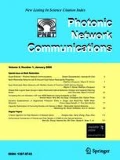Abstract
In this article, we analyze and quantify the impact of the use of different amplifier noise figure models in impairment-aware optical network simulations. We compare network simulations that use three different models, two of them already known and largely employed in the literature, and a third one that we propose here, which is more appropriate to use for gain-clamped amplifiers. We present simulation results for the network blocking probability for each model, for different amplifier output saturation powers. And we also present simulation results for the distribution of optical powers at the input of each amplifier in the network. From our results we can conclude in which cases one can use a simpler model and in which other cases it is worth using a more elaborate model. We show that if the simplest and most common model is used for any network simulation, the obtained blocking probability is overestimated.
Similar content being viewed by others
References
Konishi, C., Yoshida, T., Hamada, S., Asahi, K., Fujita, S.: Dynamic gain-controlled erbium doped fiber amplifier repeater for WDM network. In: Proceedings of Optical Fiber Communication Conference, 1997—OFC, pp. 18–19 (1997)
Krol, M.F., Liu, Y., Watkins, J.J., Dailey, M.J.: Gain variation in optically gain clamped erbium doped fiber amplifiers. In: Proceedings of 24th European Conference on Optical Communication 1998—ECOC, vol. 1, pp. 43–44 (1998)
Chung J., Kim S.Y., Chae C.J.: All-optical gain-clamped EDFAs with different feedback wavelengths for use in multiwavelength optical networks. Electron. Lett. 32(23), 2159–2161 (1996)
Bryce J., Yoffe G., Zhao Y., Minasian R.: Tunable, gain clampled EDFA incorporating chirped fibre bragg grating. Electron. Lett. 34(17), 1680–1681 (1998)
Kobayashi M.: Noise figure improvement of optical gain-clamped fibre amplifier by mid-point band reject filter to lasing light. Electron. Lett. 35(6), 486–487 (1999)
Tasushima Y., Kikuchi K.: Gain spectrum equalization of all-optical gain-clamped erbium-doped fiber amplifier. IEEE Photon. Technol. Lett. 11(2), 176–178 (1999)
Inoue K.: Gain-clamped fiber amplifier with a loop mirror configuration. IEEE Photon. Technol. Lett. 11(5), 533–535 (1999)
Ahn J.T., Kim K.H.: All-optical gain-clamped erbium-doped fiber amplifier with improved noise figure and freedom from relaxation oscillation. IEEE Photon. Technol. Lett. 16(1), 84–86 (1999)
Harun S.W., Ahmad H.: L-band erbium-doped fiber amplifier with clamped- and flattened-gain using FBG. Electron. Lett. 39(17), 1238–1240 (2003)
Zhou, L., Wang, S., Yu, Q., Jiang, Z., Wang, H., Fan, C.: Influence of power transients from gain-clamped EDFA on optical receiver BER performance. In: Proceedings of International Conference on Communication Technology 2000—WCC-ICCT, vol. 1, pp. 406–409 (2000)
Bastos-Filho, C.J.A., Melo, M.M., Martins-Filho, J.F.: Influence of pump direction in all-optical gain-clamped erbium doped fiber amplifier. In: Proceedings of International Microwave and Optoelectronics Conference 2005—IMOC, vol. 4, pp. 550–554 (2005)
Becker, P.C., Olsson, N.A., Simpson, J.R.: Erbium Doped Fiber Amplifiers, 1st edn. Academic Press (1999)
Ramamurthy B., Datta D., Feng H., Heritage J.P., Mukherjee B.: Impact of transmission impairments on the teletraffic performance of wavelength-routed optical networks. J. Lightwave Technol. 17(10), 1713–1723 (1999)
Huang Y., Heritage J.P., Mukherjee B.: Connection provisioning with transmission impairment consideration in optical WDM networks with high-speed channels. J. Lightwave Technol. 23(3), 982–993 (2005)
Cardillo, R., Curri, V., Mellia, M.: Considering transmission impairments in wavelength routed networks. In: Proceedings of Optical Network Design and Modeling, pp. 421–429 (2005)
Yang X., Shen L., Ramamurthy B.: Survivable lightpath provisioning in WDM mesh networks under shared path protection and signal quality constraints. J. Lightwave Technol. 23(4), 1556–1567 (2005)
Pavani, G., Waldman, H.: Adaptive routing and wavelength assignment with power constraints using ant colony optimization. In: Proceedings of International Telecommunications Symposium—ITS. IEEE, pp. 637–642 (2006)
Pereira H.A., Chaves D.A.R., Bastos-Filho C.J.A., Martins- Filho J.F.: OSNR model to consider physical layer impairments in transparent optical networks. Photon. Network Commun. 18(2), 137–149 (2009)
Baney D.M., Gallion P., Tucker R.S.: Theory and measurement techniques for the noise figure of optical amplifiers. Opt. Fiber Technol. 6, 122–154 (2000)
Martins-Filho, J.F., Bastos-Filho, C.J.A., Arantes, E.A.J., Oliveira, S.C., Nunes, F.D., Dante, R.G., Fontana, E.: Impact of device characteristics on network performance from a physical-impairment-based routing algorithm. In: Proceedings of Optical Fiber Communication Conference and Exposition—OFC, vol. 1. OSA, pp. 278–280 (2004)
Author information
Authors and Affiliations
Corresponding author
Rights and permissions
About this article
Cite this article
Pereira, H.A., Carvalho, R.V.B., Bastos-Filho, C.J.A. et al. Impact of amplifier noise figure modeling in simulations of impairment-aware all-optical networks. Photon Netw Commun 19, 110–120 (2010). https://doi.org/10.1007/s11107-009-0216-8
Received:
Accepted:
Published:
Issue Date:
DOI: https://doi.org/10.1007/s11107-009-0216-8




